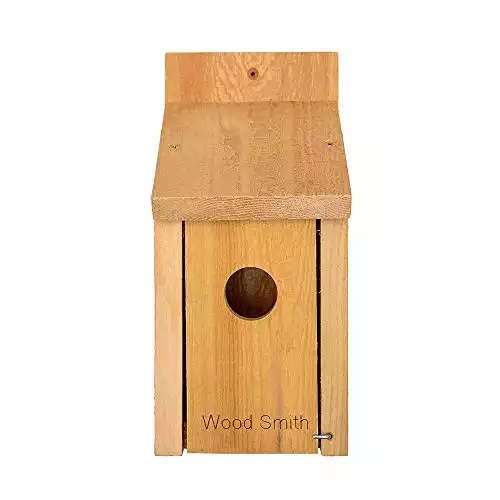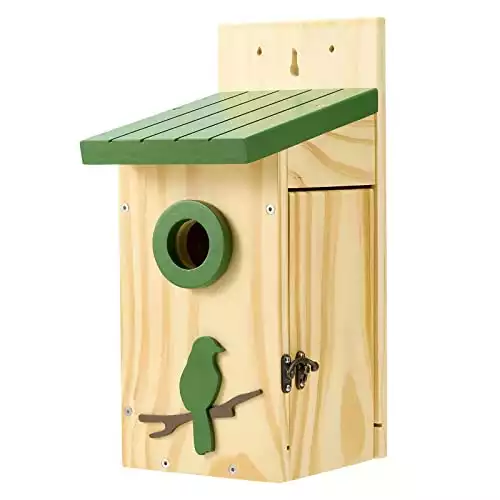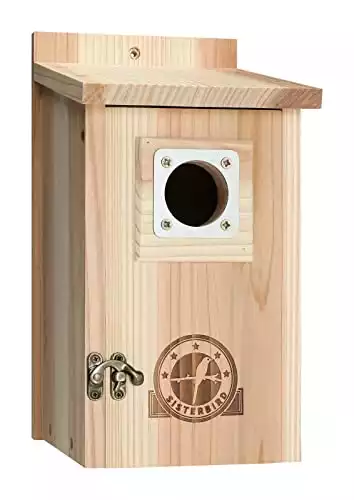Finches love birdhouses with a small entrance hole to block out predators, plenty of protection from the elements, and placed at least 5 feet off the ground. Building a DIY finch house is also easy and fun, so long as you follow specific nesting box plans.
Do you want to transform your backyard space into a goldfinch paradise? Finches are clever little birds that make their homes in the branches of shrubs and bushes and your hanging baskets and window planters! These locations are inventive but don’t offer them much protection from predators and summer thunderstorms.
You can either buy a finch bird house or make a DIY finch nesting box to ensure that your local neighborhood finches have a proper place to raise their young broods.
All you need is a set of plans, a saw, wood glue, nails, and a hammer to make a fantastic nesting box. Don’t feel like busting out your toolbox? No worries – there are also affordable nesting boxes online, and we picked the best 3!
Top 3 Comparison Table
|
|
|
|
|
Pros:
|
Pros:
|
Pros:
|
- Handcrafted design
- Materials and labor are locally sourced
- Easy to set-up and install
- Effective predator protection
- Easy access and quick cleaning
- Money back guarantee
- Quality cedar wood
- Easy and fun assembly process
- DIY option to personalize it
The Best Finch Bird Houses According to Our Team
1. Wood Smith Bird House
- Handcrafted from all-natural rustic Western red cedar
- Mimicks natural nesting habitats
- Cleaning convenience
- Air Ventilation
- Local material sourcing
- Mounting hardware included
The Wood Smith Bird House is handcrafted from all-natural rustic Western red cedar. The absence of finishes or preservatives ensures that the birdhouse is environmentally friendly, which is a great feature for those conscious about nature and wildlife.
Thanks to its 1 1/2-inch entrance hole, the bird house is specifically designed to accommodate finches and other small wild birds. The plenty of air vents ensure proper air circulation, promoting the health of the nesting birds.
The birdhouse has an easy open door with a twist latch allows for convenient cleaning, promoting good birdhouse hygiene.
Being weather-resistant, it can withstand various weather conditions, providing a reliable shelter for the birds throughout the year.
It comes with mounting hardware and sturdy weatherproof screws, making installation a simple and easy process.
Pros
- Exquisite handcrafted design
- Users who prioritize supporting local businesses will appreciate that the bird house materials and labor are locally sourced
- Easy to set-up and install
Cons
- While cedar wood is naturally resistant to decay and insects, some users might still prefer a birdhouse with additional protective finishes
2. Kingsyard Classic Bird House with Predator Guard
- High-quality natural wood
- Ventilation
- Easy cleaning and watching
- Ideal nesting environment
- Natural look
Crafted from New Zealand pine, the birdhouse’s thick and solid wood walls ensure sturdiness and durability.
The added safety extension around the entrance hole serves as a predator guard, protecting young birds from potential predators that might try to reach inside the birdhouse.
The easy-open lid allows for quick access to the bird house for cleaning purposes. Additionally, the stay-clear and crack-resistant window enables users to watch the nesting activity without causing stress to the birds.
The presence of air vents in both the walls and floor ensures maximum air flow.
The manufacturer offers a 100% satisfaction guarantee. If users are not completely satisfied, they can contact the customer support team for a full refund or replacement.
Pros
- Effective predator protection
- Easy access and quick cleaning
- Users value the assurance that they can seek a full refund or replacement if they are not completely satisfied with their purchase
Cons
The paint accents chip away over time
3. SISTERBIRD Bird House
The bird house is made from untreated, unpainted cedar, which is a durable and weather-resistant wood. The rough surface of the bird house’s front provides a foothold for birds as they enter and exit the nestbox, enhancing their access and safety.
It features a predator guard around the entrance hole to help protect young birds from potential threats. Interior grooves inside the bird house serve as a small ladder to help fledglings leave the nestbox, making it easier for swallows and bluebirds to exit the birdhouse safely.
The birdhouse’s front door opens for easy cleaning once the fledglings have left.
Users have the option to DIY and paint the birdhouse, making it special and unique to their preferences.
Pros
- The use of untreated, unpainted cedar wood is likely to be well-received by users who value durability and natural aesthetics
- Easy and fun assembly process
- The DIY option allows for personalization, enabling users to add their creative touch to the birdhouse, making it unique and special
Cons
- While untreated and unpainted cedar wood is a positive feature for many users, some might prefer birdhouses that come with a protective finish or paint for added longevity
What Type of Bird houses do Finches Like?
Finches prefer enclosed bird houses with an easy-to-access entrance hole, good ventilation, and protection from predators.
What’s interesting about finches is that they will make nests just about anywhere, from hanging baskets and atop street lamps. While these artificial nesting sites are convenient, they won’t provide as much protection from the elements and predators, which is why a nesting box for your backyard is a great idea!
In the video below, we rounded up 10 little known facts about house finches!
Tips on Building a DIY Finch Bird house
Making a DIY bird house for your neighborhood finches and goldfinches will give them a safe space to raise their broods. The best bird house for finches is strong, sturdy, secure, and of the correct dimensions to prevent more aggressive birds (looking at you, sparrows!) from deterring finches from using your birdhouse.
Even if you aren’t skilled in woodworking, making a DIY wood bird house isn’t overly complicated. It requires selecting the correct type of wood, a few essential woodworking tools, and a measuring tape!
Follow these tips below to ensure your nesting box is up to code.
Find the Right Materials
When constructing a wooden birdhouse, opt for western red cedar. If you cannot find or get your hands on this particular style of cedar, pine spruce, or redwood work well too.
Selecting soft wood is critical because it won’t warp when the temperature change, which is ideal if you live in an area that has lots of hot summer days and very frosty cold winters.
While it may seem tempting, never use pressure-treated or treated wood to construct your birdhouse.
This type of wood is often treated with pesticides and other chemicals that are not good for wild birds. Opting for natural materials whenever possible will help the environment overall.
Ensure that it is the Correct Size
The correct dimensions of a finch nesting box are six inches wide and six inches long.
You must also position the entrance hole at least four inches above the floor to protect nestlings from predators.
Drill an Entrance Hole
Ensure that your entry hole is exactly 1.8 inches in diameter. The entry hole is the most critical aspect of a finch nesting box.
It ensures it’s large enough to accommodate these small birds but not too big to invite unwanted squatters or predators!
If your entrance hole is larger than 1.8 inches, be prepared to help raise many broods of house sparrows!
Always Use Blueprints
Blueprints ensure that the style of finch house is ideal, and previously tested. Even if you have a general idea of the specifics, blueprints ensure that your nesting box can withstand years of continued use.
Using blueprints makes it a little bit easier to ensure that you have the correct dimensions for finches and boosts the chances that finches will nest in your homemade nesting box!
Skip the Perch
Wild birds don’t need perches to gain access to their nesting box. Adding a perch to your nest box makes it easier for predators to reach inside for a snack.
If you are worried that finches won’t be able to gain access to your nesting box, carve notches into the wood right below the entrance hole to hang from.
Offer Proper Drainage and Ventilation
Drainage holes ensure that the eggs and nestlings stay nice and dry during rainstorms, while proper ventilation holes keep fresh air circulating.
A hinged roof is an excellent option for ventilation and easy cleaning. For drainage holes, drill a 1/4 of an inch hole in four corners of your floor that let water escape as needed.

How Do You Attract Finches to a Bird house?
You bought a bird house or followed the tips on building your special nesting box, but it remains vacant and untouched. More often than not, vacant bird houses just haven’t been discovered yet.
Local songbirds may take a season or two to find your excellent nesting site. However, there are a few tricks and tips to ensure that your nesting box gets noticed!
- Get the nest-building process started. Placing nesting materials inside your birdhouse is an excellent way to entice local feathered friends that your nesting box is the place to be. Place anything from dried grass, twig, and pet hair inside your nest box.
- Find their favorite foods. The best way to draw finches to your backyard is to stock your birdfeeders with their favorite foods. Sunflower seeds, thistle, and suet feeders are all great options for attracting finches to your backyard. It’s also a good idea to opt for the correct type of feeder, as well. Bright yellow tube feeders and or thistle hanging socks will surely gain their attention. Also, a few well-placed birdbaths help!
- Accept that finches won’t always be your tenants. It’s difficult to only attract one type of wild bird to your backyard housing units. If you ensure that your hole size is under 2 inches, it will likely keep out pesky sparrows. However, finch houses’ building specifications are similar to purple martins, bluebirds, chickadees, nuthatches, and titmice. Keep an open mind that finches won’t be the only wild birds using your nesting box!




